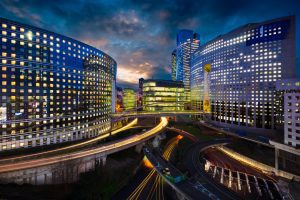Today, electrical distribution networks are undergoing significant transformation. If you run a power-critical facility, ‘status quo’ is no longer an option. I promise you, if you don’t like change, you will enjoy obsolescence even less.
Smaller facilities can adapt and modernize their power networks quickly and have already seen the positive results. But for larger facilities with critical power needs it can be more difficult. There are multiple pressures to consider and succeeding in this environment requires precision power management tools that can adapt to our ever-changing, digitized world.
Finding the right balance between energy efficiency and consumption
Those responsible for ensuring the safe, reliable and efficient delivery of power in hospitals, data centers, airports, or manufacturing plants are constantly challenged with finding and maintaining the delicate balance between energy efficiency and consumption.
The number of options available to facilities managers has significantly increased. Fueled by digitization and new technologies, power distribution systems in large facilities have gotten smarter and more complex, while onsite generation for emergency power backup and “peak shaving,” and local renewable power sources and energy storage capabilities have provided further flexibility. Effectively handling these dynamic adjustments in real-time operating conditions requires advanced power management capabilities.
Dealing with competitive forces and shareholder pressure are additional reasons why companies need to maximize operational and energy efficiency. Energy plays a significant role because reliable power has a direct effect on productivity.
Expanding regulatory requirements – from stringent energy-related emissions to hazardous materials – occur as well. But how does one ensure regulatory compliance, reduce consumption and support corporate sustainability goals?
New tools address power management challenges
The good news is tools exist to address each of these challenges:
- “Connected intelligence” – devices that can continually deliver energy, power quality, and equipment status information to help teams more easily understand and act on the information from their power networks.
- Highest possible metering accuracy – the more precise the energy metering devices, the more accurate the analytic data. This means increased confidence in energy consumption and cost calculations, and more accurate reporting on sustainability and energy-related targets.
- Modular, customizable platforms – so your power network can adapt to changing needs and new requirements of the future.
- Power monitoring and control systems – including protection against cyber threats, thanks to secure development processes and robust cyber security protocols.
- Accurate, simple-to-use power quality (PQ) analysis tools – to uncover and address the hidden risks of poor power quality.
- Advanced power system forensics – to quickly troubleshoot problems, identify hidden issues, and even help to predict component maintenance.
Find out more
Optimizing your power use and cost is imperative for any power-critical facility today. “Power management for a changing world” discusses the challenges as well as the emerging tools available to address them. Download it now to learn how to ensure you (or your customers) are taking appropriate steps.


